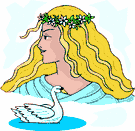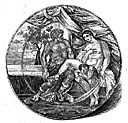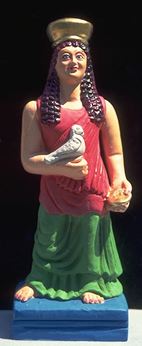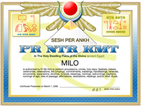
Summary: Aphrodite is the Greek Goddess of love, beauty, and the arts. Aphrodite is one of the 12 Olympians.
- names
- basic information
- relations
- magick
- symbol
- candle color
- planet
- herbs
- stones
- myths
- holy days
- Charge of the Goddess
- priests/priestesses
- links
- books
names:
Greek name: Aphrodite, Aphrodite Pandemos, Cerigo, Kypris, Cytherea
Roman/Latin name: Venus
(NOTE: In addition to native variations by locality or over time, there are often several possible transliterations into the Roman alphabet used for English.)

Aphrodite was also called Aphrodite Acidalia after the spring she bathed in, located in Boeotia.
Aphrodite was also called Kypris after the island Cyprus, one of her claimed birthplaces.
Aphrodite was also called Cytherea after the island Cythera, one of her claimed birthplaces.
Aphrodite was also called Anadyomene, or “she who emerges”, in reference to her origin in the Aegaean Sea.
Aphrodite Uranis, or the Celestial Aphrodite, is the goddess of pure and spiritual love.
basic information:
Aphrodite: Greek Goddess of love and beauty.
Aphrodite is Greek Goddess of love, beauty, the arts, fertility, and sexual rapture. Aphrodite was the protectress of sailors. Aphrodite is one of the 12 Olympians.
Aphrodite was originally a Minoan Goddess before being adopted by the Greeks.
Aphrodite’s relations:
One of the Twelve Great Olympians
Considered by the Greeks to be the same Goddess as the Roman Venus.
Greek historian Herodotus states that Aphrodite was originally an Asian goddess, related to Ishtar (Mesopotamia) and Ashtart/Astarte (Syria and Palestine).

magickal information and correspondences:
Also see the article on the Aphrodite New Moon love spell.
Symbols: scepte, myrtle, dove
Sacred candle color: pink and red
planet:
Planet: Venus ![]()
herbs associated with Aphrodite:
stones associated with Aphrodite:
The Greek goddess of love, Aphrodite, sometimes rode the ocean waves on a giant abalone shell. The Romans called Aphrodite by the name Venus (still used as a planet name).

myths and beliefs:
From the Greek writer Hesiod: Uranus (father of the Greek gods) was castrated by his son Cronus (a Titan). Cronus tossed the severed genitals into the Aegaean. The sea water churned and foamed around the severed genitals. Aphrodite arose fully formed from the foam (the Greek word aphros means sea foam) and was carried to either the island Cyprus (and therefore the Goddess is sometimes called Kypris or Lady of Kypros) or to the island of Cytherea (and therefore the Goddess is sometimes called Cytherea). Many artists depict Aphrodite arriving to the shore riding on a sea shell. Aphrodite was attended by Eros (primal god of love) and Himeros when she was born.
Because of Aphrodite’s great beauty, Zeus feared that the gods would fight wars to marry Aphrodite. So Zeus preemptively married her off to the ugly blacksmith god Hephaestus. Hephaestus created many great pieces of jewelry for his wife, including a famous girdle of finely wrought gold woven with magick in the filigree work. Aphrodite’s magick girdle made her irresistable to both god and mortal. Aphrodite loved many gods and mortals, the most famous mortals being her love affairs with Adonis and Anchises. Her divine lovers included Ares, Dionysos, and Hermes, as well as her husband Hephaistos. Some of her sons include Eros, Anteros, Hymenaios, and Aeneas (by her Trojan lover Anchises).
From the Greek poet Homer: Aphrodite is the daughter of Zeus and Dione. The Trojan War was started when the Trojan prince was asked to judge which of three Olypmian Goddesses (Hera, Athena, and Aphrodite) was most beautiful. Hera offered Paris power. Athena offered Paris victory during batte. Aphrodite offered Paris the love of the most beautiful woman in the world. Paris chose Aphrodite.
Aphrodite offered Paris Helen, Queen of Sparta, who became known as Helen of Troy when Paris eloped with her. This led to the Trojan War, with Athena and Hera supporting the Greeks, while Aphrodite and Apollo supported the Trojans.
During the Trojan War, the Greek hero Diomedes was on the verge of killing Aphrodite’s son Aeneas. Aphrodite intervened to save her son, but Diomedes attacked the Goddess, wounding her wrist with his spear. This caused the flow of ichor, which is what the Greeks believed the Immortals had instead of blood. Aphrodite dropped her son, but Apollo picked him up and rescued him.
In great pain, Aphrodite sought the assistance of her brother Ares. As god of war, Ares stood near the battle admiring the carnage. Ares loaned Aphrodite his chariot so that she could fly to Olympus. Aphrodite’s mother Dione healed Aphrodite’s wounds and soothed her feelings. Zeus advised Aphrodite to leave war to Ares and Athena and to devote herself to marriage.
Later in the Iliad Aphrodite rescues Paris from death in single combat with Menelaus (Helen’s original Spartan husband) by wrapping Paris in a mist and carrying him away to his bedroom in Troy. Aphrodite then appears to Helen in the guise of an elderly handmaiden and tells her that Paris is waiting for her. Helen recognized Aphrodite and rebukes the goddess for bringing Helen to ruin by bewitching her to elope with Paris and angrily tells the goddess to go to Paris herself. Aphrodite angrily abandoned Helen to be hated by both the Greeks and the Trojans.
Aphrodite loaned her magick girdle to Hera so that Hera could distract Zeus from the war so that the Greeks could win.
Aphrodite picked marjoram from Mount Ida to heal the wounds of Enea.
Aphrodite was accompanied by the Graces.

holy days:

Friday: Aphrodite is associated with Friday.
April: Aphrodite is associated with April.
Aphrodisiac was the fesitval to celebrate Aphrodite. The festival of Aphrodisiac was held in many places around ancient Greece, with the largest festivals in Athens and Corinth.
The priestesses of Aphrodite were considered to represent the Goddeess and one method of worshipping Aphrodite was for Greek men to have sex with the priestesses of Aphrodite. The temple would collect donations. This is sometimes called sacred prostitution and is outlawed by oppressive Christian and Muslim governments.
other:
According to Plutarch, marriages required the protection of Zeus, Hera, Aphrodite, Peitho, and Artemis.

Picture courtesy of JBL Statues this reproduction was sold by Sacred Source JBL Statues is now Sacred Source |
Aphrodite — Patroness of natural growth. Draped in the close-fitting chitton and long robe, she holds to her breast a dove or fruit or flower, all symbols of mating and fecundity. Aphrodite corresponds with Laxmi. This reproduction from the Museum of Lyon is an archaic Ionian image of the Goddess of Love which long preexisted her more eroticized depictions at the hands of Roman or Renaissance masters. Note the ritually-braided hair, the polos crown, and the quiet authority of her eyes. —picture and text © 1996 JBL Statues (now called Sacred Source), original text created by Tom Laudeman

Picture courtesy of JBL Statues
this reproduction was sold by Sacred Source
JBL Statues is now Sacred Source
Picture courtesy of Pagan Magic this reproduction was sold by Pagan Magic |
Aphrodite:
Aphrodite, the Greek goddess of love. Here she is shown drawing back her long locks to reveal the graceful lines of her neck. Beside her is a classic Greek pillar and a small vessel brimming with water to the point of overflowing. Aphrodite is known to incite feelings of love and lust wherever she goes. She is a contender in the story of the Golden Apples, when Paris chooses her as the fairest of the three goddesses (the others were Hera and Athena) and Aphrodite decides to “reward” him for giving her the Golden Apple (the prototype of most modern awards) by giving him the love of Helen of Troy, something of a mixed blessing that led to the Trojan War. This is a cold-cast resin statue measuring 11 1/4" tall, with a white finish.
Aphrodite is the Greek goddess of love, lust, beauty, and sexual reproduction. Aphrodite has numerous equivalents: Inanna, Astarte, Turan and Venus. She has parallels to Indo-European dawn goddesses such as Ushas or Aurora. It is said Aphrodite could make any man fall in love with her by them just laying eyes on her.
Aphrodite was associated with, and often depicted with the sea, dolphins, doves, swans, pomegranates, apples, myrtle, rose and lime trees, clams, scallop shells and pearls. —picture and text © 2008 Pagan Magic
Charge of the Goddess:
|
—courtesy of Aurora Lights Circle
|
religious title certificate

Get a beautiful certificate declaring that you are a priestess, priest, high priestess, high priest, witch, or shaman of Aphrodite. This is a real religious certificate meeting government standards for conducting marriages and other ceremonies.
See also Venus.
external links:
If you follow any of the links offered on this web site, no spell begging. Especially no love spell begging.
Aphrodite’s Shrine by Shekhinah.
Aphrodite her Power and her Art by Anne Lombardi is an excellent web page on how Aphrodite was depicted in classical art and what she meant to Greek culture.
Aphrodite’s Altar by Abby Willowroot (includes music).
Aphrodite Urania by Tamboura.
![]() Left section of the frieze (c. 525 B.C.) of the treasure of Siphnioi, entitled “Symposium of the Gods.” Delphi, Greece. Aphrodite. (OUTSIDE LINK — PICTURE)
Left section of the frieze (c. 525 B.C.) of the treasure of Siphnioi, entitled “Symposium of the Gods.” Delphi, Greece. Aphrodite. (OUTSIDE LINK — PICTURE)
If you have an Aphrodite-related web page, please send the URL to Milo. Please indicate if there is a picture on your web page.
click on picture for larger image
Left section of the frieze (c. 525 B.C.) of the treasure of Siphnioi, entitled “Symposium of the Gods.” Delphi, Greece. Aphrodite.
Books
If you want your book reviewed, please send a copy to: Milo, POB 1361, Tustin, CA 92781, USA.
Moon Magick: Myth & Magick, Crafts & Recipes, Rituals & Spells (Llewellyn’s Practical Magick); by D. J. Conway; Llewellyn Publications; August 1995; ISBN 1567181678; paperback; 320 pages; $13.56
![]()
If you want your book reviewed, please send a copy to: Milo, POB 1361, Tustin, CA 92781, USA.















